|
February 26, 2023
Dear Neighbors and Friends,
I hope that you and your loved ones are doing well, staying healthy, staying warm, and looking out for your neighbors and friends during this past week.
In tonight’s newsletter you’ll find a report on the latest revenue forecast for Oregon, which came out on Wednesday. It’s an important step in the process of creating the budget for the next biennium, providing us with a better sense of how much we’ll have available to invest and how much we may need to cut. As you’ll see, recent economic trends are making the state economists more optimistic that we’re not heading into a recession, but a lot of uncertainty remains right now.
Last week was an odd one in the Legislature, mainly due to Mother Nature. On Wednesday the Senate made a lot of progress on voting bills off the floor. No, that wasn’t because the required bill-reading had ended, but because the bills were all just two or three pages long, and for the most part non-controversial. (We did have a 20+ page bill but the senator slated to present it wasn’t there, so we’ll hear it tomorrow . . .) As a result, Senate President Wagner cancelled Thursday’s floor session, anticipating that the weather might be a problem.
And so it was, as became clear before the afternoon was over. The weather in Salem was fine, but we were hearing reports that such was not the case in Portland. I was able to get away and head for home (with Rep. Thuy Tran, my car-pool companion for the day) a little after 5, and I’m glad I did. We were able to get back in just a little under 2 hours, whereas it would take some of my colleagues three, four, even five or more hours to get from Salem to their homes in Portland. All of Thursday’s committee meetings and the House floor session were eventually cancelled, an extremely rare occurrence. All my Friday meetings were able to occur via zoom, so it was pretty much back to normal. (Aside from getting to snow-shoe around Portland on Thursday and Friday!)
As I mentioned in last week’s newsletter, Tuesday at 5 pm was the deadline for us to file bills for this session. It was quite the mad rush up to the end, with pleas for sponsorship coming right up to the deadline. If you go to OLIS (olis.oregonlegislature.gov), the Legislative website, and look at the First Reading lists for the next few days, you’ll see all the final bills (at least 500, maybe double that) that came in last week.
Next Saturday is the first Saturday of the month, which means it’s time for another constituent coffee! This one will be a mix of in-person at the Hollywood Senior Center and online via zoom. I promise answers to all questions! Details below.
On the COVID front, last week saw an end to the increases that we’ve been seeing in the COVID metrics here in Oregon. As you’ll see below, the numbers either stabilized or went down. Having said that, though, wastewater analysis show increases in virus all over the state, so we may well see the numbers rise again in the coming weeks.
A couple of legislators were down with COVID last week. We’ll see tomorrow if they’ve been joined by others.
Until next week, please do your best to stay happy, healthy and safe. And let me know if you have any questions or thoughts about anything in this week’s newsletter.
Next Constituent Coffee March 4th
Saturday, March 4, is the first Saturday in January, and that means time for another constituent coffee.
We’ll be back (with coffee and cookies) at the Hollywood Senior Center, 1820 NE 40th Avenue (from 9 am to 10:30 am).
This will be an opportunity for me to give you some behind-the-scenes glimpses of how the legislative session is going, how my own priority bills are doing, get your ideas for additional issues that need attention, and answer any questions that you might have.
We’ll also have a zoom option for the meeting to accommodate those who cannot be there in person. You can register in advance for the constituent coffee here.
In general, we'll continue to alternate between in-person and zoom, so the April meeting will be entirely on Zoom.
Latest Revenue Forecast: More Positive, as “Soft Landing” Seems More Likely
Life as an economic forecaster is not easy! With their latest revenue forecast, released on Wednesday, State Economists Mark McMullen and Josh Lehner signaled another shift in their prognosis for Oregon’s economy over the next biennium—fortunately in a positive direction.
You may recall that when I reported on the last revenue forecast in the November Back at the end of November 21st Newsletter, I had this to say:
Inflation, and the result of efforts to bring it down, continues to dominate the forecast.
Fortunately, Mark McMullen and Josh Lehner of the Office of Economic Analysis pointed out that inflation is continuing to show signs of reducing, thanks to reductions in gas prices and the gradual easing of supply-chain problems. They believe that we are on track to see inflation go down to 4% from the current 8%-9% in the coming months. But that’s still much higher than we’ve been used to, and the Federal Reserve wants to see it go down to 2%. To get back to that level, the Federal Reserve will likely continue to increase interest rates steadily over the coming months in an effort to slow the current growth in the economy and cool off current spending levels, both of which are contributing to inflation.
If they hit it right, we’ll have a “soft landing”—a gradual slowdown that will return us to more normal levels of growth. If they apply the brakes too hard, we’ll go into a recession, likely beginning the second half of 2023—a relatively mild recession, but a recession nonetheless, leading to layoffs, increased unemployment, and some reduction in tax revenues. In their last forecast the OEA predicted that a soft landing was more possible than not. Now they are predicting that the mild recession is slightly more likely.
However, if it does occur, it should be much, much milder than the recessions we’ve seen in recent years. We won’t see big drops in state tax revenues, but even if the Federal Reserve hits it just right and we manage to avoid a recession, we can expect growth to be slower, certainly nothing like the overheated growth we’ve been seeing as a result of pandemic payments, a hot stock market, positive capital gains, and short-term tax benefits.
In their latest forecast, the OEA has flipped back to their earlier, slightly more positive position, based on what we’ve been seeing in the economy over the last few months: Inflation is slowing, employment is up, income is up, and the likelihood of ongoing growth (albeit slow) is increasing.
So it now appears that a “soft landing” is the more possible scenario. That is the basis of their new “baseline scenario.” There’s still a chance for a mild recession, but if so, it will likely occur further into the future.
As a result, they have increased their estimates of the amount of revenue coming to the state for the remainder of this biennium (through the end of June), and in the amount coming in during the 2023-25 biennium.
Compared to the last forecast in November, we see an increase of $489 million in additional revenues coming in this biennium. Next biennium’s forecast has also been increased beyond what was projected in November: by a total of $207 million.
Thanks to Oregon’s unique constitutional “kicker” requirements, nearly all of this biennium’s increases in individual general fund revenues will turn into additional “kicker” refunds, most of them going to higher-income Oregonians. The total individual kicker is now estimated to total just under $4 billion, by far a record.
The corporate kicker, based on increases in corporate revenues, has also been estimated to increase by around $250 million from November’s estimate, for a total of $1.5 billion. These additional revenues will go to K-12 education, as required by the Oregon Constitution.
The bottom line message from the economists was to remain prudent in our plans for the 2023-25 budget. Even if we manage to avoid a recession, we need to plan for much slower increases in the growth of our economy and state revenues. They urged us not to dip into our reserves—which, thanks to careful stewardship remain among the healthiest of any state’s—anytime soon. Even though the chances of a recession have diminished, we need to remain prepared.
Here are some additional observations that came up in their presentation:
- Employment remains very solid in Oregon. Most layoff notices have been restricted to a handful of industries.
- Despite higher interest rates, construction employment remains solid.
- Potential investments in the semiconductor industry can lead to increases in state income tax revenues, as those working in semiconductor design and research earn very good salaries. However, the production workers (“the people in bunny suits”) actually earn less than the average state salary.
- One area of concern: Population growth remained low in 2021. Young professionals not moving here as much as they were. That’s a problem, something that could ultimately lead to a less optimistic forecast. An increased number of professionals working from home has led to more outmigration in all urban areas around the country. It’s still too early to tell if this is a temporary, COVID-related phenomenon or is permanently changing the workforce.
- Oregon median household income is higher than the national average, something we haven’t seen since the 1980s.
- However, Oregon has fewer households with more than $100K in income than the national average.
- Although they are doing better in the current economic recovery, Oregonians in rural areas still earn 25% on average than those living in the urban areas.
- Similarly, the pandemic recovery has helped, but massive disparities remain between White Oregonians and Oregonians of color.
- With the 2023 COLA for Social Security coming in at 8.7%, and inflation coming down strongly, we can expect added purchasing power for seniors in the coming year. This will most noticeably affect our rural and coastal counties, where the population skews older.
- Taxes are coming in at 3% over last year, which is a sign of Oregon’s economy stabilizing.
- The Corporate Activities Tax is projected to generate an additional $40 million for schools next biennium.
- Marijuana tax revenues projected to decline by $25 million over the last two forecasts. And they are forecast to continue to decline. Most of it is due to ongoing low prices due to initial overproduction.
- Bottom line: We’re in a stronger position than anticipated.
- We remain in a good position for the future thanks to our healthy reserves.
- Although we’ll have a significant amount of additional resources to work with as we craft the 2023-25 budget over the next few months, there’s still a tremendous amount of uncertainty out there.”
- We will have a much better idea of our current economic health in the May forecast, which of course follows the April 15th tax filing deadline.
Here are the PowerPoint slides from the Forecast presentation.
You can link to a video of the presentation here. Here are the detailed numbers from the Legislative Revenue Office.
For those of you interested in the detailed economic forecast narrative, with economic and demographic appendices, here it is.
And here is the Office of Economic Analysis Blog, summarizing the latest findings.
Here’s reporting on the revenue forecast from the Oregonian, and from OPB.
ON THE COVID FRONT
Weekly Data Report:
OHA now updates and reports COVID metrics once a week, on Wednesdays. Here are the most recent set of weekly results, for this past week from 2/16/23 through 2/22/23.
This week’s report shows overall stabilization of COVID metrics here in Oregon.
- The 7-day average for newly reported infections went down last week, from 408 the previous week to 385 reported infections per day this last week. The number of new cases is likely an undercount, as many people are using home tests to determine their infection status but are not reporting those results.
- Average test positivity stayed the same last week at 10.0%. The number probably skews high because it likely reflects a higher proportion of people showing COVID symptoms (and thus reporting or going in for a test, rather than self-testing and never reporting).
- On Wednesday there were again 250 COVID-19-related hospitalizations statewide. Hospitalizations are now our best indicator of disease spread. Again, however, most of these hospitalizations are not in and of themselves due to COVID—most are those who tested positive after having been admitted for other reasons.
- The number of COVID patients in Oregon’s ICUs on Wednesday also remained the same at 30.These are the most serious COVID infections.
- There were 39 COVID-19-related deaths reported during the last week, down from the previous week’s 46. However, it’s important to remember that many of every week’s reported deaths actually occurred in earlier weeks but were just reported to the state, and others that likely occurred have yet to be reported. The newsletter’s final graph shows when the deaths actually occurred, and you’ll see that the number of COVID deaths each day continues to remain relatively low.
Weekly County Report: An Improved Picture for the State, But Higher Positivity Rates in the Metro Area
The CDC assigns risk levels based on a combination of the number of new COVID cases and the number of people in hospital for COVID.
According to the CDC Daily Counter (updated each Thursday), we’re back to just one county—again Malheur in far Southeastern Oregon, at Medium Risk. The remaining 35 Oregon counties are at Low Risk.
We can also track the cases, deaths, and test positivity rates for each county at this website.
Positivity rates for the three Portland-area counties increased again last week. Clackamas County in now at 10.1% (up slightly from 10.0% the previous week). Multnomah County has gone up to 7.7% (from 7.2%). Washington County has gone up to 11.1% (up from 10.4%).
Remember that these are all based on reported test results, and so are more likely to be a little higher than the total percent positivity (i.e., if one were to include all tests taken).
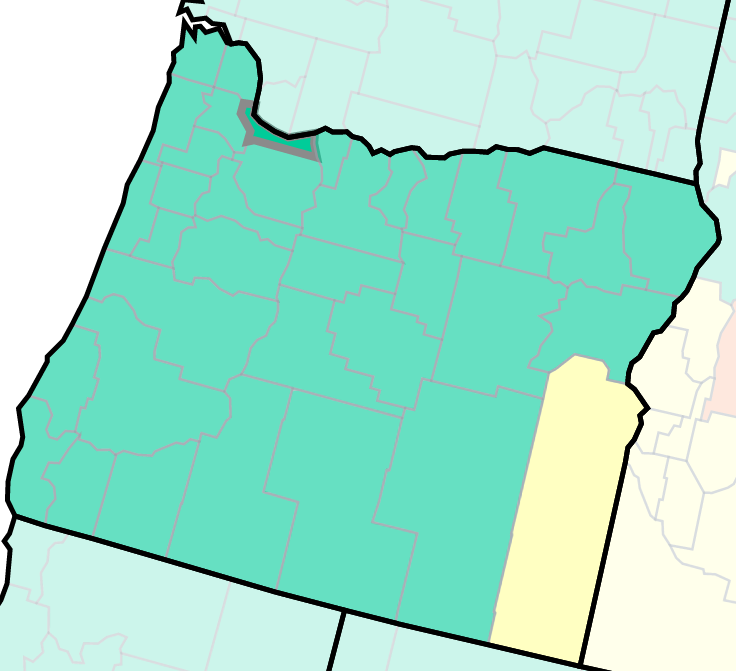 
This Week’s Wastewater Monitoring Report: Big Increases Around the State
With testing reports giving us just a fraction of infections out there, wastewater monitoring has become a more reliable indicator of the amount of virus in cities around the state. That report is updated each week.
This week’s report, updated on Wednesday, showed a jump in increased viral detection, with the viral loads in a number of cities rising. Nearly half the cities studied (46%) saw increases and sustained increases (up from 18% the previous week). Only 6% showed decreases and sustained decreases (down from 14%). The remaining 48% showed no change (down from last week’s 68%).
Astoria, Durham, Forest Grove, Grants Pass, Hermiston, Hillsboro, Medford, Newberg, and Siletz were the cities showing sustained increases in last week’s report.
COVID Q & A from OHA (from OHA weekly newsletter)
The OHA Immunization program and the Long COVID-19 Program team at Oregon Health & Science University answered today’s questions.
Q: I’m wondering what research is being done on long COVID-19/post-viral infections and prolonged symptoms, and whether and how people can volunteer to participate in research. – T., Portland
A: “Researchers continue to actively study long COVID-19 and are learning more every day about the condition and how to treat it. For example, Oregon Health and Science University (OHSU) co-led a study that was published Feb. 14 in the journal JAMA Network Open. That study followed 825 adult patients after they were discharged from a hospital for a serious case of COVID-19, and it found that about half of those patients were still experiencing lingering symptoms, financial difficulties or physical limitations months after being discharged. These important findings can help physicians better care for patients and also inform future research. More information is available in this NIH press release.
“Patients who are interested in participating in long COVID-19 research should discuss this with their health provider. If Oregonians experiencing long COVID-19 need more help from clinicians who specialize in this condition, they should speak with their primary care provider about getting a referral to one of the long COVID-19 programs at OHSU, Kaiser Permanente or Providence.”
Q: I am a five-dose-boosted 74-year-old male, the most recent being the Pfizer bivalent administered Nov. 11, 2022. The only risk category that applies to me is age. Because the effectiveness of COVID-19 vaccines is known to diminish over time, am I eligible to get a second bivalent booster before the Public Health Emergency is scheduled to end later this year, while they are still free? – Rick, Corvallis
A: “At this time, the FDA has authorized only one dose of the COVID-19 bivalent booster, regardless of age or other risk factors.
“The Affordable Care Act currently requires health insurance companies to cover any vaccines recommended by the Centers for Disease Control and Prevention (CDC), which includes COVID-19 vaccines. So, if you have private health insurance or are a member of Oregon Health Plan (Medicaid), there will likely be no cost to you for future COVID-19 vaccines. If you don’t have health insurance, the cost of COVID-19 vaccines after the public health emergency ends May 11 is being determined. This table lays out what we know at this time.”
Additional COVID Updates and Links
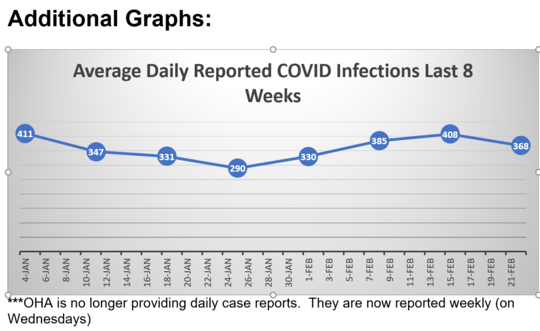



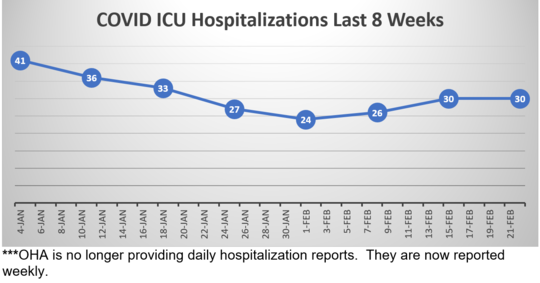
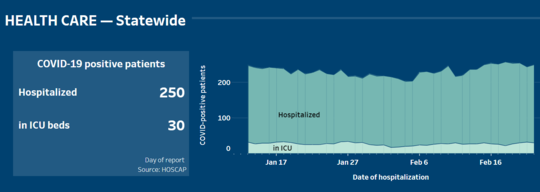
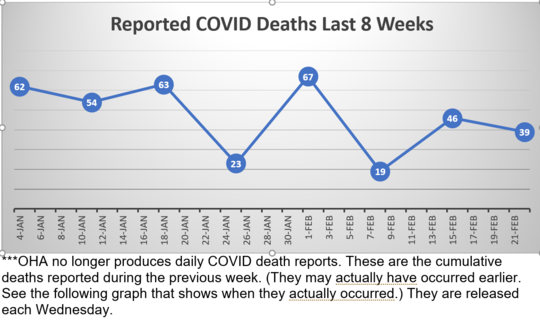

Here again are some COVID resources that you will find useful:
If the above links are not providing you with answers to your questions or directing you to the help that you need, please consider me and my office to be a resource. We’ll do our best to assist you or steer you in the right direction.
 Senator Michael Dembrow
District 23
email: Sen.MichaelDembrow@oregonlegislature.gov
web: www.senatordembrow.com
mail: 900 Court St NE, S-407, Salem, OR, 97301
|